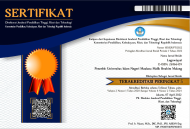Author Guidelines
Lugawiyyat is published by PKPBA (A Special Program for Developing Arabic) published twice a year multilingual (Arabic, English, and Indonesian); journal with a peer-review policy of open access. The goal is to interpret and develop a better understanding of Arabic education for readers; and presents it through published articles and research reports.
Manuscripts must be written in Arabic, English, or Indonesian; and it had never been published before or were in the process of filing publications elsewhere and it did not contain any plagiarism.
The script will be reviewed by the subject's reviewer, while the editor has the right to edit for consistency of the format without altering substance. Make sure that the script is prepared according to Lugawiyyat's journal.
The manuscript must be sent to the website Lugawiyyat (OJS). Use the access guide to Lugawiyyat for online submissions. Citation and reference should use American Psychological Association (APA) 7th edition style with Zotero or Mendeley.
Structure of the Manuscript:
Loading structure: a) Title; b) Authors, Affiliates, and Emails; c) Abstract; d) Keywords; e) Introduction; f) Methods; g) Results and Discussions; h) Conclusion; i) Reference. The number of words in the journal article is 5,000-6,000 words.
-Title-
The title of the article must be brief, specific, and informative, not more than 12 words; As discussed. The main idea was written in advance and followed by its explanation.
-Author-
The writer's name is written completely without any title. Affiliates were written and included in full form along with the city names. Correspondence writer: names and email addresses.
-Abstracts-
Abstracts are comprehensive summaries of the content of articles that enable readers quickly to survey content (purpose, methods, and research results). Abstract writing in English (for Arabic and Indonesian articles); And Indonesian. The word limit in the abstract is between 100-150 words, with Cambria font size 11 and space 1.
-Keyword-
Keywords are a label of important manuscripts for correcting indexing and searching. Therefore, keywords are intimately related to the topic and are well-chosen to facilitate the search for the reader in representing content and spotlight in the article. There are 3-5 keywords (words or phrases) separated by commas (,).
-Introduction-
In the introduction, the writer presented sufficient background with clear supporting theory, novelty, and writing purposes. Written in a chapter without sub-titles. The introduction contains three to five paragraphs in which one paragraph must contain at least 10-15 rows.
-Method-
This section describes the methods used in research, including: 1) research design/approach; 2) population and sample; 3) data collection techniques and instrument development; 4) data analysis. The method has 2-3 paragraphs (not just 1 paragraph).
-Result and Discussion-
The discussion in the study article explains the results. The writer compiles, analyzes, evaluates, and interpreters and compares the recent findings with those from the existing study (at least 5 references). Avoid the repetition of sentences either from the introduction, method, or outcome. The number of discussion paragraphs should be longer than the introduction.
-Conclusion-
The conclusions contain the answers to the research problems. The conclusion is the essence of the discussion and should be the answer to the research questions in a descriptive form. Is written in narrative, not in numerical form. Suggestions were given based on research.
-References-
The article contains at least 30 references made up of primary sources such as journals and levels by 80% and 20% of secondary reference sources (books) published in the last 10 years. Writing of references using (innate). Writing a library list using Mendeley or Zotero (with style APA 7th edition).
Examples of citations in the text:
طعيمة, ر. أ. ( 1986) . المرجع في تعليم اللغة العربية للناطقين بلغات أخرى. القاهرة: معهد اللغة العربية لغير الناطقين بها جامعة أم القرى.
Afifuddin, Ahmad & Beni Soebani. 2009. Metodologi Penelitian Kuantitatif, Bandung: Pustaka Setia.
Hao, Q., Branch, R. M., & Jensen, L. (2016). The Effect of Precommitment on Student Achievement Within a Technology-Rich Project-Based Learning Environment. TechTrends, 60(5), 442–448. https://doi.org/10.1007/s11528-016-0093-9





